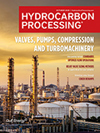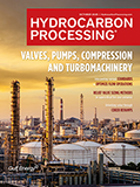Heat Transfer
Use CFD modeling to improve burner design and operation
Process heaters are essential pieces of equipment in the refining and petrochemical industry that are used to heat hydrocarbons to a desired temperature.
Refinery tower inspections: Discovering problems and preventing malfunctions
A previous survey identified installation mishaps to be one of the top five causes of tower malfunctions.
Water Management: Minimize white rust in galvanized cooling systems
Galvanized coatings for cooling tower systems (cooling towers, evaporator tube bundles, etc.) have been used in the industry since the 1950s due to their relatively low cost and long service life.
Cost-effective naphtha hydrotreating unit revamp to increase high-octane reformate production
India, which is the third-largest economy in the world, is home to nearly 18% of the world’s population (nearly 1.4 B).
Case study: Extend tube life in a waste heat boiler
The sulfur recovery unit (SRU) separates sulfur from sulfur compounds.
Apply ceramic coatings to extend radiant tube life in process heaters
Process tubes in refining applications are typically steel alloy (ASTM A335 P22, P5 or P9), which contain 2.25%, 5% and 9% Cr, respectively. These grades oxidize at operating temperatures, and scale will grow continuously on the surface, often reaching 2 mm in thickness in higher-temperature/high-heat-flux units. The layers of scale are very insulating and represent a significant barrier to conductive heat transfer to the process.
Optimal gas analysis decisions improve ethylene plant operation
One of the most common and important building blocks in the petrochemical industry is ethylene, constituting a huge and fast-growing worldwide industry. Ethylene is an intermediate chemical used to manufacture many commercial products—approximately 200 MMt will be produced in 2020.
Case study: Heat exchanger tube rupture and its impact on metal embrittlement
Process engineers strive to recover as much energy as is practically possible from the available process and utility streams within the constraint of the plant. To achieve this goal, traditional—and sometimes non-traditional—methods are utilized. In a steam cracker, light olefins are considered the highest-value products, and utilizing “cold energy,”
Heat Transfer: Designing electric process heater systems for catalytic regeneration
Achieving effective catalyst regeneration requires a process that produces a very high level of heat in a very efficient manner. Over the years, several different approaches have been taken to create this required heat. Traditional steam has been a popular choice, as has heated transfer media. However, these methods have limitations.
Rethink fired heater design for emissions
As environmental regulations are becoming more stringent on reduced nitrogen oxide and carbon monoxide emissions, burner designs are changing to meet revised regulations. The heater design must complement the chosen burner for optimal performance. Although design duty is considered to be the main focus of the heater design, the range of heater operation and its impact on heater safety and emissions needs are often neglected.

- Asian gasoline margin spikes to highest since August 2023 11/14
- Lukoil-Moldova grants free use of airport fuel terminal to government amid U.S. sanctions 11/14
- Croatia rejects Russian vacuum gasoil cargo after U.S. sanctions 11/14
- Bulgaria wins UK sanctions reprieve on refinery, petrol stations 11/14
- China's Sinochem shuts one crude unit at Quanzhou after fire 11/14
- Enbridge approves $1.4-B project to boost Canadian oil flows to U.S. refiners 11/14




